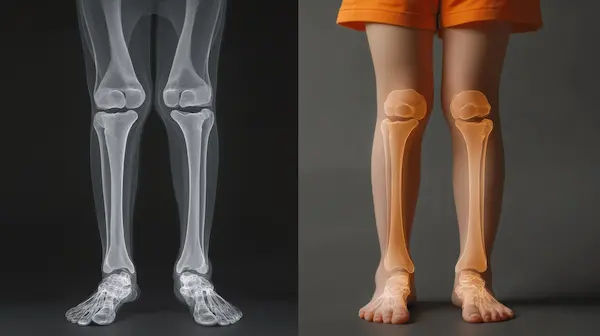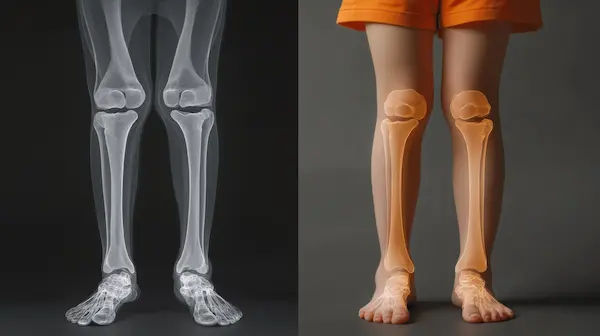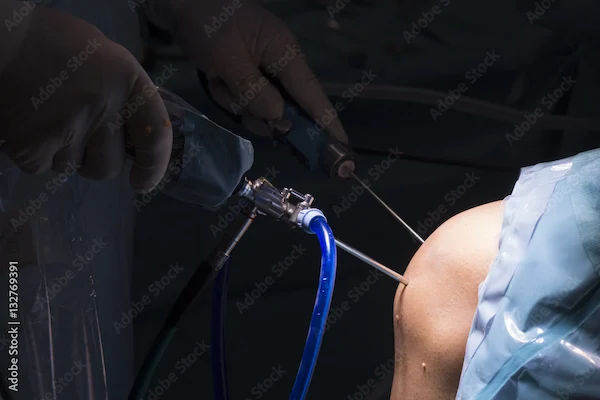Guide to Knock Knees
Understand knock knees (genu valgum) with our complete guide. Learn about the causes in children and adults, common symptoms, treatment options, and when to seek medical advice.

Written by Dr. J T Hema Pratima
Reviewed by Dr. Dhankecha Mayank Dineshbhai MBBS
Last updated on 22nd Sep, 2025

Introduction: What Are Knock Knees?
Have you ever noticed someone whose knees touch when they stand with their feet apart? This common postural alignment is known as knock knees, or by its medical term, genu valgum. It's a condition where the knees angle inward and touch each other, while the ankles remain separated. For many young children, this is a normal part of growth and development. However, when it persists into adolescence or adulthood, or if it causes pain, it can be a sign of an underlying issue. This comprehensive guide will walk you through everything you need to know about knock knees—from distinguishing normal development from potential problems, to exploring the causes, symptoms, and the full spectrum of treatment options available. Whether you're a concerned parent or an adult seeking answers, we’ll help you understand when it's time to watch and wait, and when it's time to seek professional advice.
Is It Normal? Knock Knees in Children vs. Adults
Understanding the context of age is crucial when evaluating knock knees.
Physiological Genu Valgum in Kids
In children, knock knees are often a standard stage of lower limb development. Most infants are born with bowlegs (genu varum). As they begin to walk, typically between 18 to 24 months, the legs often straighten out and then progress into a knocked-knee appearance. This alignment is usually most noticeable around ages 3 to 4. The body typically self-corrects this physiological genu valgum by the time the child reaches 7 or 8 years old. This natural process requires no intervention unless the angle is extreme, asymmetric (one leg is significantly more knocked than the other), or accompanied by pain.
Pathological Knock Knees in Adults
When knock knees persist beyond the age of 8-10 or develop in adulthood, it is considered pathological. Adult-onset genu valgum is not a normal part of aging and is often caused by an underlying condition, injury, or degenerative disease. This type of misalignment can place abnormal stress on the knee joint, leading to pain, accelerated cartilage wear, and an increased risk of osteoarthritis.
What Causes Knock Knees? The Underlying Reasons
The causes of knock knees are varied and depend largely on whether the condition is physiological or pathological.
Health Topic Carousel:
Doctor Speciality: Orthopedic
Text: Consult Top Specialists for personalised tips
Common Nutritional and Metabolic Causes
Historically, vitamin D and calcium deficiencies leading to rickets were a primary cause of severe knock knees. While nutritional rickets is less common in developed countries today, it still occurs. Metabolic bone diseases like osteomalacia (the adult equivalent of rickets) can also soften bones and lead to progressive malalignment.
Underlying Bone Diseases and Conditions
Several genetic and skeletal conditions can cause pathological genu valgum. These include:
Osteoarthritis: Degenerative wear on the outer part of the knee can cause the joint to collapse inward.
Rheumatoid Arthritis: An autoimmune disease that causes inflammation, which can damage joints and ligaments, leading to deformity.
Obesity: Excess weight can place increased stress on growth plates in children and joints in adults, contributing to malalignment.
Genetic Conditions: Diseases like skeletal dysplasias or Blount’s disease can affect normal bone growth around the knee.
Injury and Trauma-Related Causes
A traumatic injury to the growth plate around the knee in a child can disrupt normal bone development, causing one leg to grow at an angle. In adults, a fracture that doesn't heal properly (malunion) or severe ligament damage (like an MCL tear) can result in a valgus deformity.
Recognizing the Symptoms: More Than Just Appearance
While the inward angling of the knees is the most visible sign, other symptoms of knock knees can include:
Knee Pain: Often on the inner side of the knee due to compressed joints.
Gait Abnormalities: An awkward or clumsy walking pattern, sometimes with a swaying motion.
Foot or Ankle Pain: The misalignment can cause excessive pressure on the outer side of the foot.
Stiffness in the Hips, Knees, or Ankles.
A Limp while walking.
Reduced Range of Motion in the knees.
Knee Instability or a feeling of the knee "giving way."
If you or your child experiences persistent pain or any of these symptoms beyond the expected age of correction, it's important to consult a medical professional. If symptoms persist beyond two weeks, consult a doctor online with Apollo24|7 for further evaluation.
How Are Knock Knees Diagnosed?
A proper diagnosis is essential for creating an effective treatment plan.
The Physical Examination and Gait Analysis
A doctor will begin by taking a medical history and observing the patient stand and walk. They will measure the distance between the ankles (the intermalleolar distance) while the knees are touching. This provides a baseline to monitor progression or improvement. They will also assess gait to identify any abnormalities.
The Role of Imaging: X-Rays and Scans
To confirm the diagnosis and measure the severity, weight-bearing X-rays of the legs are the gold standard. These images allow the doctor to calculate the tibiofemoral angle—the precise angle of deformity. This measurement is critical for deciding on treatment, especially if surgery is being considered. In complex cases, a CT scan might be used for more detailed 3D planning. Apollo24|7 offers convenient home collection for tests like vitamin D or HbA1c, which can be useful if a metabolic cause is suspected.
Knock Knees Treatment: From Observation to Surgery
Treatment is not always necessary and is highly individualized based on age, cause, and severity.
Non-Surgical Management and Watchful Waiting
For young children with physiological genu valgum, the standard treatment is observation. The condition usually corrects itself without any intervention.
The Power of Physical Therapy and Targeted Exercises
For mild cases in adults and children, physical therapy for knock knees is a cornerstone of management. A physical therapist can design a program to:
Strengthen hip abductors (especially the gluteus medius) and external rotators to improve pelvic stability.
Strengthen the quadriceps and hamstrings to support the knee joint.
Improve flexibility in tight IT bands and hip flexors.
Correct gait patterns.
Orthotic Devices: Braces and Shoe Inserts
In some growing children with moderate knock knees, guided-growth braces may be used to gently direct bone growth. For adults, custom orthotic shoe inserts can help correct foot positioning and distribute pressure more evenly, reducing pain in the knees, ankles, and feet.
Surgical Intervention: Osteotomy for Severe Cases
Surgery is typically reserved for severe, painful, or progressive deformities that do not respond to conservative care. The most common procedure is a osteotomy, where a wedge of bone is either removed from or added to the femur or tibia to realign the limb. This is a major surgery with a significant recovery period but can effectively reduce pain and prevent further joint degeneration.
5 Effective Exercises for Managing Knock Knees
Note: Always consult a doctor or physical therapist before starting a new exercise regimen.
1. Clamshells: Lie on your side with knees bent and stacked. Keeping your feet together, lift your top knee toward the ceiling without rotating your pelvis. This strengthens the gluteus medius.
2. Side-Lying Leg Lifts: Lie on your side with your bottom leg bent for support and your top leg straight. Lift the top leg toward the ceiling, engaging your outer hip muscles.
3. Glute Bridges: Lie on your back with knees bent and feet flat. Squeeze your glutes to lift your hips toward the ceiling, creating a straight line from shoulders to knees.
4. Band Walks: Place a resistance band around your ankles or just above your knees. Slightly bend your knees into a mini-squat and take slow, controlled steps sideways.
5. Foam Rolling the IT Band: Roll the outer side of your thigh on a foam roller to release tension in the IT band, which can pull the knee inward.
Conclusion: Living Comfortably with Knock Knees
Understanding knock knees is the first step toward managing them effectively. For parents, this knowledge provides reassurance that their child's development is likely on track. For adults, it offers a roadmap to address discomfort and improve joint health. While physiological genu valgum requires patience, pathological cases benefit greatly from a proactive approach involving accurate diagnosis and a tailored treatment plan. By strengthening the right muscles, maintaining a healthy weight, and seeking professional guidance when needed, individuals with knock knees can lead active, comfortable lives and protect their long-term joint function. Don't let uncertainty hold you back—addressing knee alignment issues today can prevent more significant problems tomorrow.
Health Topic Carousel:
Doctor Speciality: Orthopedic
Text: Consult Top Specialists for personalised tips
Frequently Asked Questions (FAQs)
1. At what age should knock knees correct themselves?
In children, knock knees typically peak around age 4 and should gradually correct on their own by age 7 or 8. If they persist beyond age 10, it's advisable to see a doctor.
2. Can you fix knock knees with exercise?
While exercise cannot change the actual bone structure, targeted exercises for knock knees can significantly improve symptoms. Strengthening hip and glute muscles helps correct muscle imbalances, improves alignment during movement, and reduces pain, effectively managing the condition.
3. What is the difference between bow legs and knock knees?
Bow legs (genu varum) are an outward curvature of the legs where the knees are apart when the feet are together. Knock knees (genu valgum) are the opposite—an inward curvature where the knees touch but the ankles do not.
4. What kind of doctor should I see for knock knees?
You should start with a general physician or pediatrician. They will likely refer you to an orthopedic specialist (orthopedist) who specializes in bone and joint conditions.
5. Is knock knees surgery painful?
As with any major surgery, there will be a postoperative pain management period. However, surgeons use a multi-modal approach (including nerve blocks and medications) to control pain effectively. The long-term benefit of pain relief from the corrected alignment often outweighs the temporary surgical discomfort.



